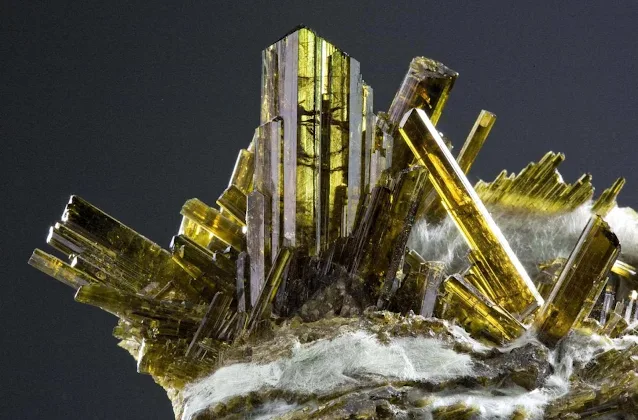Epidote
Epidote is a calcium aluminium iron sorosilicate mineral, meaning it's a complex silicate with a specific chemical formula and structure. Its name comes from the Greek word "epidosis" meaning "addition," referring to the characteristic elongation of one side of its crystal prism.
Epidote is an abundant rock-forming mineral, but one of secondary origin. It occurs in marble and schistose rocks of metamorphic origin. It is also a product of hydrothermal alteration of various minerals (feldspars, micas, pyroxenes, amphiboles, garnets, and others) composing igneous rocks.Epidote is a silicate mineral that is typically observed in domestically metamorphosed rocks of low-to-slight grade. In those rocks, epidote is often associated with amphiboles, feldspars, quartz, and chlorite. It occurs as replacements of mineral grains which have been altered by using metamorphism.
 |
| Magnificent Epidote Crystals on Byssolite Matrix, From: Alchuri, Shigar Valley, Skardu District, Baltistan, Northern Areas, Pakistan Photo Credit: Irocks/The Arkenstone |
Epidote Properties
Composition: Epidote is a calcium aluminum iron silicate hydroxide with the chemical formula Ca₂Al₂(Fe³⁺,Al)(SiO₄)(Si₂O₇)O(OH).
Color: Epidote is typically green in color, but it can also be found in shades of yellow, brown, and black. The green color is due to the presence of iron in the crystal lattice.
Hardness: Epidote has a hardness ranging from 6 to 7 on the Mohs scale.
Crystal system: Monoclinic, meaning its crystals have three unequal axes and two right angles.
Transparency: Translucent to semi-transparent, allowing some light to pass through.
Luster: Vitreous (glassy) to resinous, giving it a shiny appearance.
Cleavage: Perfect in one direction, meaning it can break cleanly along a specific plane.
Other interesting features: It can be fluorescent under ultraviolet light and can exhibit pleochroism, where its color appears to change depending on the viewing angle.
Epidote Occurrence
Epidote's occurrence is quite diverse, found in various geological settings across the globe. Here's a deeper dive into where you might encounter this fascinating mineral:
Main Geological Environments
Regionally Metamorphosed Rocks:
- Schists: Resulting from high-pressure, low- to medium-temperature metamorphism, schists often contain epidote as a secondary mineral, formed during the alteration of pre-existing minerals like pyroxene and amphibole.
- Marbles: Metamorphosed limestones often host epidote, particularly in association with other minerals like calcite, garnet, and diopside.
Altered Igneous Rocks
Granites: Hydrothermal alteration of granites can introduce epidote, replacing minerals like feldspar and pyroxene. This process is particularly common in contact zones where hot magma interacts with surrounding rocks.
Greenschists: These fine-grained metamorphic rocks, formed from basaltic igneous rocks under low-pressure, low-temperature conditions, often contain epidote as a result of mineral transformations.
Hydrothermal Veins: Mineral-rich fluids circulating through cracks and fractures in rocks can deposit epidote during their cooling and crystallization. These veins can be valuable sources of epidote crystals.
Other Occurrences
Skarn Deposits: These are mineral deposits formed at the contact zones between igneous intrusions and carbonate rocks. Epidote can be a significant constituent of skarns, particularly when associated with copper, zinc, or tungsten mineralization.
Serpentinites: Ultramafic rocks like serpentinites can host epidote as a secondary mineral due to alteration processes.
Alluvial Deposits: Weathering and erosion of epidote-bearing rocks can transport and concentrate epidote crystals in riverbeds and alluvial plains.








%20(1).webp)